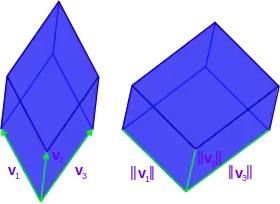Polar sine
In geometry, the polar sine generalizes the sine function of angle to the vertex angle of a polytope. It is denoted by psin.
Definition
n vectors in n-dimensional space

Let v1, ..., vn, for n ≥ 2, be non-zero Euclidean vectors in n-dimensional space (ℝn) that are directed from a vertex of a parallelotope, forming the edges of the parallelotope. The polar sine of the vertex angle is:
where the numerator is the determinant
equal to the hyper volume of the parallelotope with vector edges[1]
and in the denominator the n-fold product
of the magnitudes ||vi|| of the vectors equals the hypervolume of the n-dimensional hyperrectangle, with edges equal to the magnitudes of the vectors ||v1||, ||v2||, ... ||vn|| (not the vectors themselves). Also see Ericksson.[2]
The parallelotope is like a "squashed hyperrectangle", so it has less hypervolume than the hyperrectangle, meaning (see image for the 3d case):
and since this ratio can be negative, psin is always bounded between −1 and +1 by the inequalities:
as for the ordinary sine, with either bound only being reached in case all vectors are mutually orthogonal.
In case n = 2, the polar sine is the ordinary sine of the angle between the two vectors.
n vectors in m-dimensional space for m ≥ n
A non-negative version of the polar sine exists, which works in any m-dimensional space for m ≥ n. In this case, the numerator in the definition is given as
where the superscript T indicates matrix transposition. In the case that m=n, the value of Ω for this non-negative definition of the polar sine is the absolute value of the Ω from the signed version of the polar sine given previously.
Properties
- Interchange of vectors
If the dimension of the space is more than n then the polar sine is non-negative and is unchanged whenever two of the vectors vj and vk are interchanged. Otherwise, it changes sign whenever two vectors are interchanged - due to the antisymmetry of row-exchanging in the determinant:
- Invariance under scalar multiplication of vectors
The polar sine does not change if all of the vectors v1, ..., vn are multiplied by positive constants ci, due to factorization:
If an odd number of these constants are instead negative, then the sign of the polar sine will change; however, its absolute value will remain unchanged.
- Vanishes with linear dependences
If the vectors are not linearly independent, the polar sine will be zero. This will always be so in the degenerate case that the number of dimensions m is strictly less than the number of vectors n.
See also
References
- Lerman, Gilad; Whitehouse, J. Tyler (2009). "On d-dimensional d-semimetrics and simplex-type inequalities for high-dimensional sine functions". Journal of Approximation Theory. 156: 52–81. arXiv:0805.1430. doi:10.1016/j.jat.2008.03.005.
- Eriksson, F (1978). "The Law of Sines for Tetrahedra and n-Simplices". Geometriae Dedicata. 7: 71–80. doi:10.1007/bf00181352.
- Euler, Leonhard. "De mensura angulorum solidorum". Leonhardi Euleri Opera Omnia. 26: 204–223.